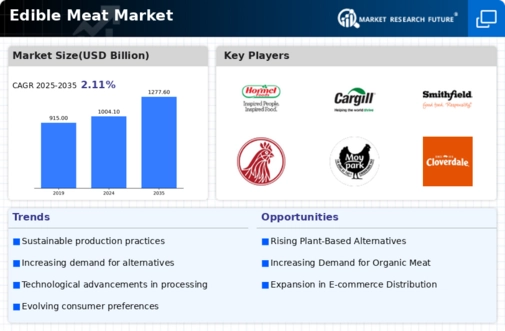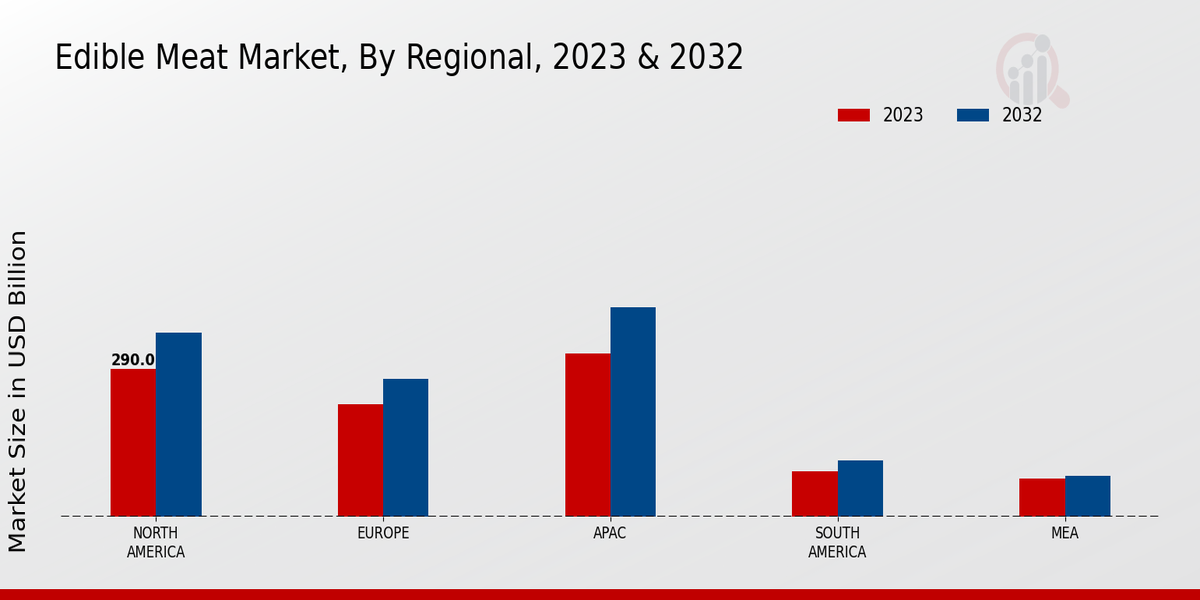Rising Global Population
The Global Edible Meat Market Industry is experiencing growth driven by the increasing global population, which is projected to reach approximately 9.7 billion by 2050. This demographic shift leads to higher demand for protein-rich foods, particularly meat. As urbanization continues, dietary preferences are shifting towards meat consumption, particularly in developing regions. For instance, countries in Asia are witnessing a surge in meat demand, contributing significantly to the market's expansion. The Global Edible Meat Market is expected to reach 1004.1 USD Billion in 2024, reflecting the necessity to meet the nutritional needs of a growing population.
Market Growth Projections
The Global Edible Meat Market Industry is poised for substantial growth, with projections indicating a market value of 1004.1 USD Billion in 2024 and an anticipated increase to 1277.6 USD Billion by 2035. This growth trajectory suggests a robust demand for meat products across various regions, driven by factors such as population growth, health trends, and technological advancements. The market is expected to expand at a CAGR of 2.21% from 2025 to 2035, reflecting a stable outlook for stakeholders. These projections underscore the importance of strategic planning and innovation within the industry to capitalize on emerging opportunities.
Health and Wellness Trends
The Global Edible Meat Market Industry is influenced by evolving health and wellness trends, as consumers increasingly seek high-protein diets. This shift is prompting a rise in demand for lean meats and organic options, which are perceived as healthier alternatives. For example, poultry and fish are gaining popularity due to their lower fat content and higher nutritional value. The market is adapting by introducing products that cater to these preferences, including organic and free-range meats. As a result, the Global Edible Meat Market is projected to grow steadily, with a CAGR of 2.21% from 2025 to 2035, indicating a long-term commitment to health-conscious consumption.
Sustainability and Ethical Consumption
Sustainability and ethical consumption are becoming pivotal drivers in the Global Edible Meat Market Industry. Consumers are increasingly concerned about the environmental impact of meat production and are seeking products that align with their values. This trend has led to a rise in demand for sustainably sourced and ethically raised meat. Brands that prioritize transparency in their supply chains and adopt environmentally friendly practices are gaining a competitive edge. As the market adapts to these consumer preferences, it is likely to see continued growth, contributing to the projected CAGR of 2.21% from 2025 to 2035, as sustainability becomes a core consideration in purchasing decisions.
Growing Demand for Processed Meat Products
The Global Edible Meat Market Industry is witnessing a notable increase in demand for processed meat products, driven by changing consumer lifestyles and preferences. Busy schedules and the convenience of ready-to-eat meals are propelling the popularity of products such as sausages, deli meats, and pre-cooked options. This trend is particularly evident in urban areas where consumers prioritize convenience without compromising on taste. As a result, the processed meat segment is expected to contribute significantly to the overall market growth, aligning with the anticipated market value of 1004.1 USD Billion in 2024, as consumers increasingly seek quick and easy meal solutions.
Technological Advancements in Meat Production
Technological advancements in meat production are significantly impacting the Global Edible Meat Market Industry. Innovations such as precision farming, genetic engineering, and improved processing techniques are enhancing efficiency and sustainability. For instance, the adoption of automation in processing plants is reducing waste and improving product quality. These advancements not only increase production capacity but also address consumer concerns regarding food safety and environmental impact. As the industry evolves, these technologies are likely to play a crucial role in meeting the projected market value of 1277.6 USD Billion by 2035, reflecting a commitment to sustainable practices.














